
A percussion instrument is a musical instrument that is sounded by being struck or scraped by a beater including attached or enclosed beaters or rattles struck, scraped or rubbed by hand or struck against another similar instrument. Excluding zoomusicological instruments and the human voice, the percussion family is believed to include the oldest musical instruments.
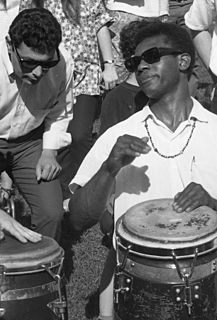
A drummer is a percussionist who creates music using drums.

Religious music is a type of music that is performed or composed for religious use or through religious influence. It may overlap with ritual music, which is music, sacred or not, performed or composed for or as ritual. Religious songs have been described as a source of strength, as well as a means of easing pain, improving one's mood, and assisting in the discovery of meaning in one's suffering. While style and genre vary broadly across traditions, religious groups still share a variety of musical practices and techniques.

The music of Korea refers to music from the Korean peninsula ranging from prehistoric times to the division of Korea into South and North in 1945. It includes court music, folk music, poetic songs, and religious music used in shamanistic and Buddhist traditions. Together, traditional Korean music is referred to as gugak, which literally means "national music."
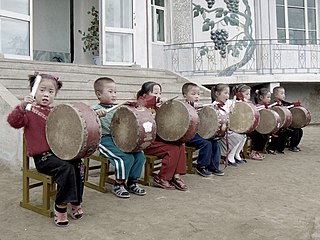
The music of North Korea includes a wide array of folk, pop, light instrumental, political, and classical performers. Beyond patriotic and political music, popular groups like Pochonbo Electronic Ensemble and Moranbong Band perform songs about everyday life in the DPRK and modern light pop reinterpretations of classic Korean folk music. Music education is widely taught in schools, with President Kim Il-Sung first implementing a program of study of musical instruments in 1949 at an orphanage in Mangyongdae. Musical diplomacy also continues to be relevant to the Democratic People's Republic of Korea, with musical and cultural delegations completing concerts in China and France in recent years, and musicians from Western countries and South Korea collaborating on projects in the DPRK.
Gagaku is a type of Japanese classical music that was historically used for imperial court music and dances. Gagaku was developed as court music of the Kyoto Imperial Palace, and its near-current form was established in the Heian period (794-1185) around the 10th century. Today, it is performed by the Board of Ceremonies in the Tokyo Imperial Palace.

The geomungo or hyeongeum is a traditional Korean plucked zither with both bridges and frets. Geomungo is a representative stringed instrument made in Goguryeo before the 5th century. Scholars believe that the name refers to Goguryeo and translates to "Goguryeo zither" or that it refers to the colour and translates to "black crane zither".

The music of Myanmar shares many similarities with other musical styles in the region. Traditional music is melodic, having its own unique form of harmony, often composed with a 4
4 (na-yi-se), a 2
4 (wa-let-se) or a 8
16 time signature. In Burmese, music segments are combined into patterns, and then into verses, making it a multi-level hierarchical system. Various levels are manipulated to create a song. Harmony in Mahagita is known as twe-lone, which is similar to a chord in western music. For example, C is combined with F or G.

Marching percussion instruments are instruments specially designed to be played while moving. This is achieved by attaching the drum(s) to a special harness worn by the drummer, although not all marching bands use such harnesses and instead use traditional baldrics to sling their drums.
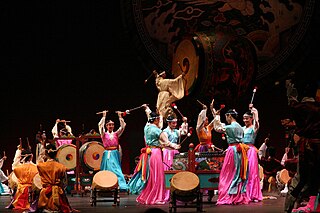
Dance in Korea began with shamanistic early rituals five thousand years ago and now ranges from folk dance to newly created and adopted contemporary dance.
Sanjo, literally meaning 'scattered melodies', is a style of traditional Korean music, involving an instrumental solo accompanied by drumming on the janggu, an hourglass-shaped drum. The art of sanjo is a real crystallization of traditional Korean melody and rhythm which may have been handed down by rote generation after generation. The drummer who beats the janggu also makes chuimsae (exclamations) in order to please the audience. The audience can also express their excited feeling with chuimsae while listening to sanjo. A big chuimsae indicates a good performance, so the musician can make a better performance. Like pansori, chuimsae plays an important role in sanjo. Without chuimsae, the music is meaningless. Chuimsae connects musician and audience during a sanjo performance. Almost every Korean traditional musical instrument is used in sanjo: gayageum, geomungo, daegeum, haegeum, piri, taepyeongso, ajaeng, danso.

Samul nori (사물놀이) is a genre of percussion music that originated in Korea. The word samul means "four objects", while nori means "play". Samul nori is performed with four traditional Korean musical instruments called pungmul. These are Kkwaenggwari (꽹과리), a small gong; Jing (징), a larger gong; Janggu (장구), an hourglass-shaped drum; and Buk (북), a barrel drum similar to the bass drum.

The taepyeongso is a Korean double reed wind instrument in the shawm or oboe family, probably descended from the Persian sorna and closely related to the Chinese suona. It has a conical wooden body made from yuja (citron), daechu (jujube), or yellow mulberry wood, with a metal mouthpiece and cup-shaped metal bell. It originated during the Goryeo period (918–1392).
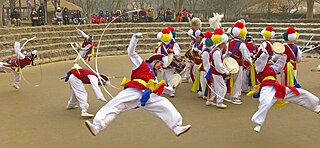
Pungmul is a Korean folk music tradition that includes drumming, dancing, and singing. Most performances are outside, with dozens of players all in constant motion. Pungmul is rooted in the dure farming culture. It was originally played as part of farm work, on rural holidays, at other village community-building events, and to accompany shamanistic rituals, mask dance dramas, and other types of performance. During the late 1960s and 1970s it expanded in meaning and was actively used in political protest during the pro-democracy movement, although today it is most often seen as a performing art.

The ajaeng is a Korean string instrument. It is a wide zither with strings of twisted silk. It is played with a slender stick of forsythia wood that is drawn across the strings in the manner of a bow. The ajaeng mainly plays the bass part in ensemble music. And the ajaeng is divided into two types. The ajaeng used in court music is called jeongak ajaeng, and the ajaeng used in folk music is called sanjo ajaeng. The original version of the instrument, and that used in court music, has seven strings; while the ajaeng used for sanjo and sinawi has eight. Some instruments have as many as nine to twelve strings.
Gagok is a genre of Korean vocal music for mixed female and male voices.

Daechwita is a genre of Korean traditional music consisting of military music played by wind and percussion instruments, generally performed while marching or as a static performance.

Shamanic music is ritualistic music used in religious and spiritual ceremonies associated with the practice of shamanism. Shamanic music makes use of various means of producing music, with an emphasis on voice and rhythm.
A prakhom band is a type of traditional Thai music band employed to play ceremonial music–known as prakhom music–during certain Thai rituals. Today, they report to the Bureau of the Royal Household's (BRH) Royal Ceremonial Division, and are responsible for the playing of traditional songs during royal events of the Royal Family of Thailand, in a custom known as prakhom yam yam or royal ceremonial music performances. The Prakhom Band plays the prakhom part of state events involving the Thai Royal Family and are distinguished by their red dress uniforms and pith helmets. As the term states they play ceremonial music every three hours during state funeral rites to signal officials and staff members of the Royal Family and the ensemble plays in other events like state coronations, royal anniversaries and the State Opening of the National Assembly.
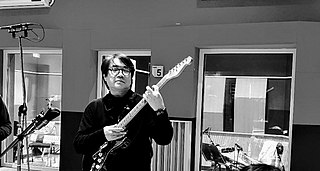
Won Il(Korean: 원일; RR: Won Il), stylized as IL WON, is a Korean modern musician mainly based on Korean traditional music. He won four times at the Grand Bell Awards which is often regarded as South Korea's Academy Awards.















